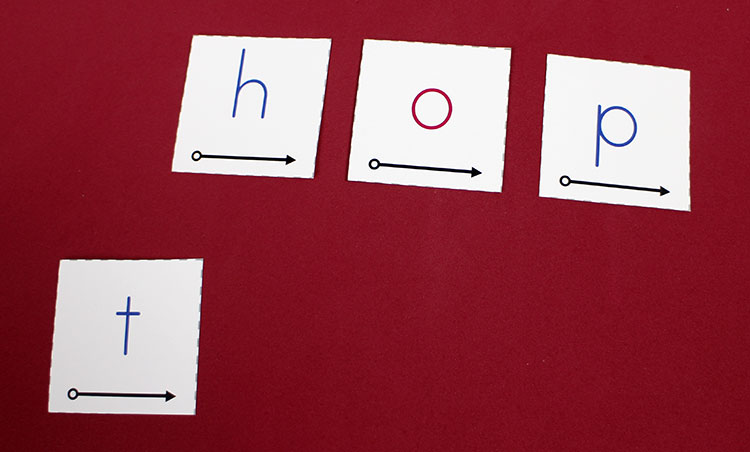L3: First Sound Swap
1. Overview
Produce and then read three-sound words by swapping out the beginning sounds to make new words in the same word family.
L3: First Sound Swap
2. Materials & Preparation
Print out the sound cards and the word work mat, preferably on sturdy card-stock paper, and cut apart the sound cards. For the word work mat, trim off the white edges and tape the pages together. Put the word work mat directly in front of your child. The word list is for the adult’s reference only. All the words in this activity contain short vowel sounds, so do a quick review of those sounds with your child. Use the Egbert picture, the Bingo Vowel Song, and the vowel picture cards as needed. The child should be able to quickly give the sound for each vowel when he sees the letter card as well as picking out the letter that goes with each vowel sound. ↑ Top3. Activity
Video: How to play First Sound Swap
Have the child put the sound cards in their matching squares on the word work mat, giving the sound for each letter or digraph as he moves the card to its place.
You will guide your child through building a three-sound word on his word work mat and then swapping the first sound to make other words in the same word family. Until he gets the hang of the activity, skip over words and word stems that contain digraphs (ch, sh, th, wh, and ng).
In the example below, we will lead a child through the words in the -ab word family, starting with cab.
Adult: Let’s play another game where you swap sounds to make new words. I’ll say three sounds, and you find each sound and move the card to the boxes at the bottom of the mat. Start here. [Point to left box.] Get ready: /c/ [child moves card] … /aaa/ [child moves card] … /b/ [child moves card] Now say the sound for each card. Start here. [Point to left box.] Child: /c/ • /aaa/ • /b/. Adult: Say the sounds fast. What word? Child: /c/-/aaa/-/b/. Cab! Adult: Good job. Now put the /c/ card back in its place. Swap it for the /d/ card. Child: [Swaps cards.] Adult: Say the sound on each card. Get ready: Child: /d/ • /aaa/ • /b/. Adult: Say the sounds fast. What word? Child: /d/-/aaa/-/b/. d/a/b. Dab! Adult: Yes. You swapped the first sound to turn cab into dab. Now put the /d/ card back and swap it for the /g/ card.Continue until your child has made all the words you have selected from that word family. Once the child has correctly made all the swaps in the word family, reverse the order. Go through the word family backward, from the final word tab back to cab. Have the child put all three sound cards back in their places before beginning a new word family. Go through about twenty words (two to four word families) in a session. NOTE: You do not have to cover every word in a word family or even every word family. We have provided a large variety of words from which you can choose. NOTE: Do not go so fast in this game that your child gets frustrated and discouraged. It is better to introduce just five to six words (and sound swaps) in one word family and repeat them in random order several times than it is to confuse or overwhelm the child by presenting too many word stems in a session. Your child’s success with initial sound swaps will make the subsequent Beginning Reading games much easier for him. ↑ Top
4. Confidence Builder
Revisit Activity J15: Sneak Preview of Reading. It is very similar to this game but uses only a few of the sound cards on the word work mat at a time. Another option is to start with just one word family (-ab) and its associated sound cards. Go through those words and their sound swaps several times in random order until the child can confidently make the swaps, identify the sounds, and say the new words. Then add a second word family (-ad) and its sound cards to the mat, and go through both word families in a session. Only after the child has mastered those two word families and sounds will you move on the the -ag and -am word families and add their sound cards to the word work mat. Then move on to the -an, -at, and -ax families, then -ed and -eg, until all the sound cards have been added to the word work mat. ↑ Top5. Small Groups (2-5 children)
Lesson Objective: Using visual aids, children will hear individual phonemes in a three-sound word, identify and correctly order their corresponding lower-case alphabet letter cards to build the word, read the word, and then swap the initial phoneme sound cards to produce and read a new word. GELDS (Georgia Early Learning & Development Standards): CLL6.4f (closest standard) Georgia Standards of Excellence: ELAGSEKRF2.e Common Core State Standards: CCSS.ELA-LITERACY.RF.K.2.E Additional Materials:- optional: pocket chart to display work mat and sound cards
Leave a Reply

One Response to “L3: First Sound Swap”
Lindsay
I love this activity, although I believe it would be filed under the umbrella of “phonics,” not, “phonemic awareness,” as it presents the symbol in print alongside the practice of the sounds. Phonemic awareness is wholly auditory, without the symbols attached to the practice. Just a thought.
ADMIN – Hi Lindsay,
You are correct! This final module of our Phonemic Awareness curriculum is designed to be a bridge leading from Phonemic Awareness into Phonics and Reading.